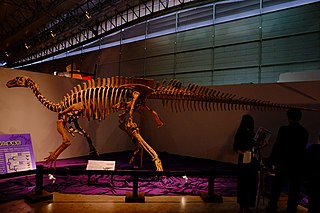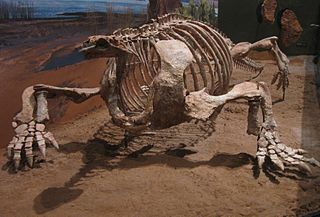
Mamenchisaurus is a genus of sauropod dinosaur known for their remarkably long necks which made up nearly half the total body length. Numerous species have been assigned to the genus; however, the validity of these assignments has been questioned. Fossils have been found in the Sichuan Basin and Yunnan Province in China. Several species from the Upper Shaximiao Formation, whose geologic age is uncertain, have been described. However, evidence suggests this formation to be no earlier than the Oxfordian stage of the Late Jurassic. M. sinocanadorum dates to the Oxfordian stage, and M. anyuensis to the Aptian stage of the Early Cretaceous. Most species were medium-large to large sauropods, measuring roughly 15 to 26 meters in length—possibly up to 35 meters (115 ft), based on two undescribed vertebrae.

Crichtonsaurus is a genus of herbivorous ankylosaurid dinosaur that lived during the Late Cretaceous in what is now China. It was named after Michael Crichton, the author of the dinosaur novel Jurassic Park. A sister taxon was discovered, C. benxiensis, which is now identified as a separate genus.
Yimenosaurus is an extinct genus of plateosaurid sauropodomorph dinosaur that lived in China in the Early Jurassic. The genus was first named in 1990 by Ziqi Bai, Jie Yang and Guohui Wang, along with its type and only species, Yimenosaurus youngi. The species name honours renowned Chinese paleontologist Yang Zhongjian, the father of Chinese paleontology, known as C.C. Young in English. Known material includes the holotype, an almost complete skull and mandible, as well as incomplete cervical and dorsal vertebrae, a mostly complete sacrum, an ilium, ischia, partial ribs and complete femur, and a paratype, a well-preserved postcrania with a fragmentary skull. In 2010 Paul estimated its length at 9 metres (30 ft) and its weight at 2 tonnes.

Equijubus, is a genus of herbivorous hadrosauroid dinosaur from the Early Cretaceous of northwestern China.
Casea is a genus of herbivorous caseid synapsids that lived during the late Lower Permian (Kungurian) in what is now Texas, United States. The genus is only represented by its type species, Casea broilii, named by Samuel Wendell Williston in 1910. The species is represented by a skull associated with a skeleton, a second skull, a partial skull with a better preserved dentition than that of the preceding skulls, and several incomplete postcranial skeletons. Three other Casea species were later erected, but these are considered today to be invalid or belonging to different genera. Casea was a small animal with a length of about 1.20 m and a weight of around 20 kg.

Acaenasuchus is an extinct genus of pseudosuchian, endemic to what would be presently be known as Arizona during the Late Triassic, specifically during the Carnian and Norian stages of the Triassic. Acaenasuchus had a stratigraphic range of approximately 11.5 million years. Acaenasuchus is further categorized as one of the type fauna that belong to the Adamanian LVF, based on the fauna of the Blue Mesa Member of the Chinle Petrified Forest Formation of Arizona, where Acaenasuchus was initially discovered.

Cotylorhynchus is an extinct genus of herbivorous caseid synapsids that lived during the late Lower Permian (Kungurian) and possibly the early Middle Permian (Roadian) in what is now Texas and Oklahoma in the United States. The large number of specimens found make it the best-known caseid. Like all large herbivorous caseids, Cotylorhynchus had a short snout sloping forward and very large external nares. The head was very small compared to the size of the body. The latter was massive, barrel-shaped, and ended with a long tail. The limbs were short and robust. The hands and feet had short, broad fingers with powerful claws. The barrel-shaped body must have housed large intestines, suggesting that the animal had to feed on a large quantity of plants of low nutritional value. Caseids are generally considered to be terrestrial, though a semi-aquatic lifestyle has been proposed by some authors. The genus Cotylorhynchus is represented by three species, the largest of which could reach more than 6 m in length. However, a study published in 2022 suggests that the genus may be paraphyletic, with two of the three species possibly belonging to separate genera.
Angelosaurus is an extinct genus of herbivorous caseid synapsids that lived during the late Lower Permian (Kungurian) and early Middle Permian (Roadian) in what is now Texas and Oklahoma in the United States. Like other herbivorous caseids, it had a small head, large barrel-shaped body, long tail, and massive limbs. Angelosaurus differs from other caseids by the extreme massiveness of its bones, particularly those of the limbs, which show a strong development of ridges, processes, and rugosities for the attachment of muscles and tendons. Relative to its body size, the limbs of Angelosaurus were shorter and wider than those of other caseids. The ungual phalanges looked more like hooves than claws. The few known cranial elements show that the skull was short and more robust than that of the other representatives of the group. Angelosaurus is also distinguished by its bulbous teeth with shorter and wider crowns than those of other caseids. Their morphology and the high rate of wear they exhibit suggests a diet quite different from that of other large herbivorous caseids, and must have been based on particularly tough plants. A study published in 2022 suggests that the genus may be paraphyletic, with Angelosaurus possibly only represented by its type species A. dolani.

Chroniosuchus is an extinct genus of chroniosuchid from the upper Permian period. The genus was first named by Vjuschkov in 1957.

Bystrowiana is an extinct genus of bystrowianid chroniosuchian from upper Permian deposits of Vladimir Region, Russia and Jiyuan, China. Chroniosuchians are often thought to be reptiliomorphs, but some recent phylogenetic analyses suggest instead that they are stem-tetrapods. The genus is named in honour of the Russian paleontologist Alexey Bystrow. It was first described by Vyushkov in 1957 and the type species is Bystrowiana permira. Two species—B. permira and B. sinica—are known.

Bystrowiella is an extinct genus of bystrowianid chroniosuchians from upper Middle Triassic deposits of Kupferzell and Vellberg, northern Baden-Württemberg, Germany.

Axitectum is an extinct genus of bystrowianid chroniosuchians from lower Triassic deposits of Nizhni Novgorod and Kirov Regions, Russia. It was a rather large animal judging by the size of its vertebrae. The back was covered in bands of highly ornamented osteoderm plates, similar to those found in modern crocodiles. The bands overlapped with the next band at the posterior end.

Dromotectum is an extinct genus of bystrowianid chroniosuchians from the Late Permian of China and Early Triassic of Russia. Two species have been named: the type species D. spinosum and the species D. largum. D. spinosum, the first species to be named, comes from Lower Triassic deposits in the Samara Region of European Russia and is known from the holotype PIN 2424/23, which consists of armor scutes, and from PIN 2424/65, 4495/14 and 2252/397. It was found in the Staritskaya Formation of the Rybinskin Horizon and named by I.V. Novikov and M.A. Shishkin in 2000. The generic name means “corridor with hipped vault” + “roof” (tecton), and the specific name means “spinous”. A second species, D. largum, was named by Liu Jun, Xu Li, Jia Song-Hai, Pu Han-Yong, and Liu Xiao-Ling in 2014 from the Shangshihezi Formation near Jiyuan in Henan province, China on the basis of specimen IVPP V 4013.1, a large scute.
Synesuchus is an extinct genus of bystrowianid chroniosuchians from middle Triassic deposits of Komi Republic, northern Fore-Ural of Russia. It is known from the holotype PIN 4466/12, which consists of armor scute and from the referred materials PIN 4466/10, 4466/11, 4466/13 and 4466/14. It was found in the Nadkrasnokamenskaya Formation of the Bukobay Horizon. It was first named by I.V. Novikov and M.A. Shishkin in 2000 and the type species is Synesuchus muravjevi. The generic name comes from Syne, from Bolshaya Synya river, and “crocodile”, and the specific name honors the Russian geologist Ivan Stepanovich Murav'ev.
Kunpania is an extinct genus of dicynodont therapsid from the Quanzijie Formation of Xinjiang, China. The type and only species is K. scopulusa, and it is known only by a single incomplete specimen including parts of the skull and forelimb. Since its initial description in 1978 by palaeontologist Ailing Sun, it has sometimes been considered to be another species of Dicynodon by other researchers, or potentially undiagnostic. However, a redescription in 2021 reaffirmed its distinctiveness, including a uniquely well developed muscle attachment on the humerus. Kunpania is perhaps the oldest known member of the derived dicynodont group Dicynodontoidea, potentially dating to the Middle Permian period during the Capitanian, and so may fill a knowledge gap in the history of dicynodont evolution.

Padillasaurus is an extinct genus of titanosauriform sauropod known from the Early Cretaceous Paja Formation in Colombia. It contains a single species, Padillasaurus leivaensis, known only from a single partial axial skeleton. Initially described as a brachiosaurid, it was considered to be the first South American brachiosaurid ever discovered and named. Before its discovery, the only known brachiosaurid material on the continent was very fragmentary and from the Jurassic period. However, a more recent study finds it to be a basal somphospondylan.

Almas is a genus of troodontid theropod dinosaur from the Late Cretaceous of Mongolia. It contains a single species, Almas ukhaa, named in 2017 by Pei Rui and colleagues, based on a partial articulated skeleton. The only known specimen was found in the Djadochta Formation, which is late Campanian in age.

Laosuchus is an extinct genus of chroniosuchian known from the Permian-Triassic boundary of Asia. Two species have been named.
Ruixinia is an extinct genus of somphospondylan titanosauriform dinosaur from the Early Cretaceous (Barremian) Yixian Formation of China. The genus contains a single species, Ruixinia zhangi. The Ruixinia holotype is a partial articulated skeleton with the most complete series of caudal vertebrae known from any Asian titanosauriform.
Hassiacoscutum is an extinct genus of bystrowianid chroniosuchian found in the Korbach Fissure of the Werra Formation in Hesse, Germany.












